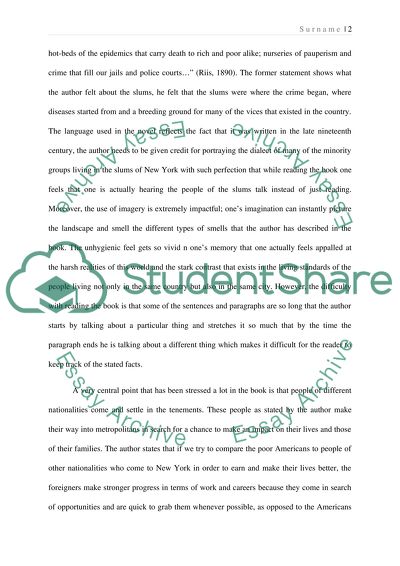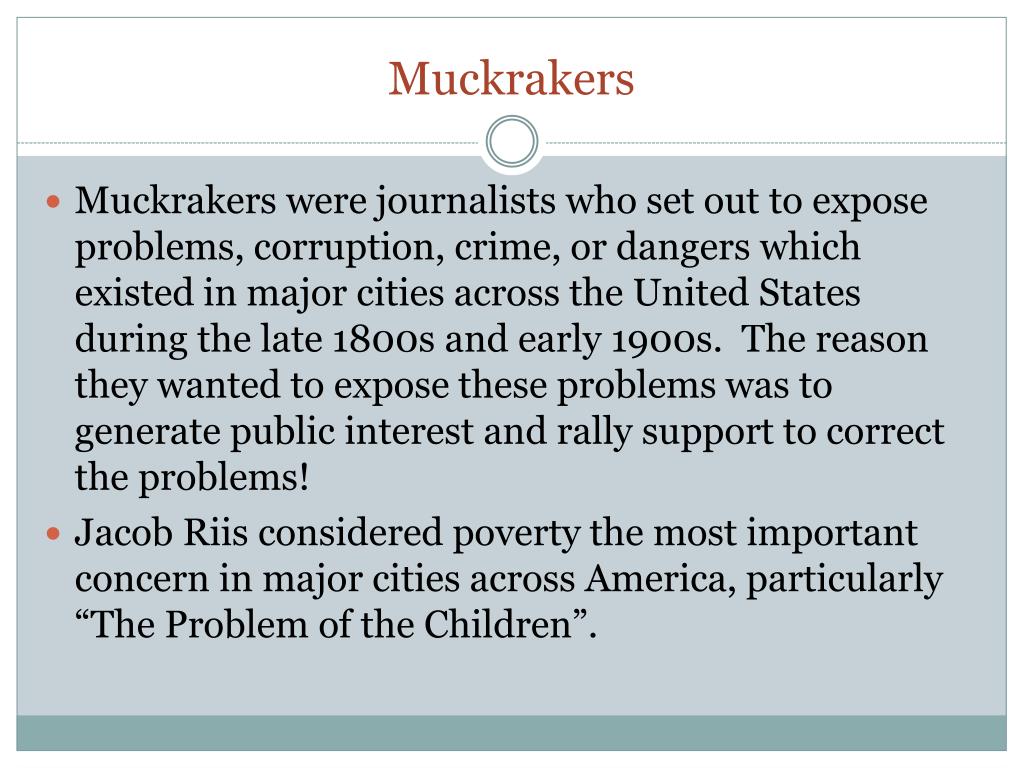
In the book "How the Other Half Lives," by Jacob Riis, the author writes about the living conditions of the tenement houses. Housed in these apartments were mostly poor immigrants trying to survive. Riis, a photographer, captured the unhealthy, unclean and horrible conditions not only through his words but mostly through his pictures How the Other Half Lives Introduction The book How the Other Half lives, is one of those books that definitely affects you as soon as you read it. Jacob Riis the author of the book, wrote it exactly for the purpose, to affect people and get them to realize how bad the conditions were back then in New York City. He goes into full depth, of what the living conditions were like, who lived in them, and how they Essay Paper Help ‘If you haven’t already tried taking essay paper help How The Other Half Lives Essays from TFTH, I strongly suggest that you do so right away. I How The Other Half Lives Essays used to wonder how a company can service an essay help so well that it earns such rave reviews from every other student. But the, I got essay help online from them and realised why that is the case’
How the Other Half Lives Essay - Words | Bartleby
These unbelievably harsh living conditions can be seen on image 1 and 3 where families are forced to live in an overcrowded and inadequate room. There was a very high demand of houses and many were constructed in terraced rows that can be seen in image 4.
Some of these houses had just a small yard at the rear where an outside toilet was placed. The people who lived in cities needed cheap homes as the Industrial Revolution continued to grow.
Some families were lucky, being able to afford the rooms with windows, how the other half lives essay others had to live in pitch-black, damp, and tiny rooms literally in the center of the building.
These tenements contained inadequate living conditions; disease murdered many citizens, causing a shortage of industrial workers. middle of paper ew York City in the 19th century. The reader will realize not every immigrant coming to America for a better life will live out their dream. However, how the other half lives essay, I would not recommend How the Other Half Lives to those uninterested in the origins of New York City, the 19th century, and optimists wanting to avoid negative ideas.
The Industrial Revolution created the new working class. Comparing to the life of the wealthy and people in middle class, the housing conditions of the industrial workers seemed outlandish.
They were packed into tenements, or multistory buildings divided into tiny rooms, how the other half lives essay, with no running water, sewage, nor clean drinking water. Their wastes were dumped onto the streets and rivers. On top of these harsh conditions, the sanitation system in these tenements were extremely poor which caused the widespread of diseases, such as cholera. The living conditions of tenements set up for factory workers were horrendous. Because there was no running water or sewage system, waste was dumped into the rivers creating a horrible stench throughout the city.
Drinking water became contaminated and diseases such as cholera spread throughout the city "Social Impact," n. Child labor was rampant during the Industrial Revolution because cheap labor was vital to the profitable production of textiles. how the other half lives essay Responses to the Industrial Revolution. During the mids, conditions in New York City were atrocious; immigrants lived in squalor in rundown tenements, and most if not all were in low paying jobs with no chance of improvement.
New York did not have the infrastructure capable of handling its population, and the city was falling apart. In the s, a group came into power that turned the city around. They funded the building of bridges, hospitals, and parks, and provided financial aid to immigrants, including helping them find jobs and avoid the draft. This led to divided social classes within the neighborhoods of Boston, but the city learned to survive through tolerance Handlin Argument: In the yearBoston was ranked third amongst American cities population wise, but its population began diminishing due e by Miss Martineau on page After reading this entire book I learned about how the Irish were cast as the scum of society, only important because of their low work wages.
What they underwent in the factories was grueling and demanding and they made very little, while a white collared American made a fortune. One social reformer, by the name of Jacob Riis, exposed these appalling conditions to the American public through his experience with journalism and photography and uncovered the horrific effects of Urbanization and Industrialization in New York How the other half lives essay in the late nineteenth century and the early twentieth century.
His actions sustained the Progressive Movement in the city and were the reasons how the other half lives essay several measures taken by the city to repair these social ills. ob Riis helped reform the urban slums and poorly kept tenement housing in the city of New York; however, he also aided in a widespread movement known as the Progressive Era that swept the nation and caused a surge social reform and activism.
Thousands of children from seven to fourteen years were compulsory to work from six o'clock in the morning to seven o'clock in the evening with no more than a half an hour break.
Machines were also sometimes hazardous so workers could get injured or even die. Wages were so poor in mills that workers could just afford to pay the how the other half lives essay on their accommodation leaving them with barely anything else for other necessities.
A classic example of a industrial city with pitiable surroundings in this period was Bradford in the North of England, how the other half lives essay. One man who wanted to bring to an end all these conditions was Titus Salt who was born in and raised up in Bradford. This seemed to be the worst place to end up, as many people would rather have died than gone into the workhouses.
When people went to the workhouses, they were separated from their families, forced to work long hours and hardly fed at all. The workhouse system was the upper classes solution to poverty, but it did not help at all.
The lower classes were still living very hard lives. Dickens published 'A Christmas Carol' in to try to bring the lower classes hard lives to the attention of people who could do something about it; the upper classes. The problem of unemployment leads to all the other problems. Without employment the people have no money so they have to live in shanty towns where the crime, facilities, violence and cleanliness are all at a much worse standard than in the rich areas.
Home Page How The Other Half Lives Reflection. How The Other Half Lives Reflection Satisfactory Essays. Open Document. Essay Sample Check Writing Quality. American History II A Reflection on "How the Other Half Lives" by the Other Half The author of "How the Other Half Lives", Jacob Riis, inscribes on the deplorable living conditions of the Progressive Era from a first-person perspective. Riis, an immigrant, police reporter, photojournalist and most importantly: a pioneer and social reformer, tells a very captivating yet appalling experience of the lower class life in New York City beginning in the 19th century.
Migration and the standardization of establishments are the attributing factors to overpopulation distribution and overcrowding of living arrangements in the city. With the ever growing craze of coming to America and starting a new and better life many immigrants had to start from the bottom, and many stayed there.
Ethnic groups tended to stick together and in result "claimed" their own territory; many worked low-wage jobs and were poverty-stricken. The only affordable shelter in close proximity to work and their community were overcrowded housing tenements, overcrowded being an understatement. From to tenement housing almost tripled to over 37, tenements in use. p Riis Houses and blocks were turned into barracks, giving how the other half lives essay whole new meaning to overcrowding, and the expense unjust compared to living conditions.
Tenements were the equivalent of coal mines; in early developments there were no safety standards, just the quickest way to make the most amount of money, how the other half lives essay, with lack of sunlight and air ventilation. The epitome of poor management regarding the lack of attempt of turnabout in the nature of tenements by landlords were shown through model tenements; the care and up-keeping focused mainly in the facade of buildings rather than continual care within the walls of confinements.
Mortality rates in the city rose to one-in-twenty-seven persons in due to the severe lacking living conditions and negligence of owners, landlords and agents. p11, Riis Any case of disease that arose within the walls of a tenement was a formula for disaster. Typically the disease-stricken tenants were a lost cause, how the other half lives essay, and the source of plague throughout other blocks.
The mortality rate didn't lie, but the landlords did not see that because of the ill-paced illnesses, which led to a citizen movement that resulted in the organization of the Board of Health.
The Health Department began to educate the public more than help the public; however, in years to come they ordered tenements to be ventilated by way of air shafts and ordered the installation of windows, which slowly led to the declination, and soon thereafter extinction of the "dark room". Get Access.
Satisfactory Essays. Industrial Revolution Essay Words 2 Pages. Industrial Revolution Essay. Read More. Powerful Essays. How the Other Half Lives by Jacob A. Riis Words 5 Pages. Better Essays. The New Working Class Created by the Industrial Revolution Words 2 Pages 5 Works Cited, how the other half lives essay.
The New Working Class Created by the Industrial Revolution. Good Essays. The First Industrial Revolution Words 2 Pages 5 Works Cited. The First Industrial Revolution. Boss Tweed And Tammany Hall Essay Words 2 Pages. Boss Tweed And Tammany Hall Essay. Jacob Riis And Urban Reform Words 3 Pages. Jacob Riis And Urban Reform. Exploration of Saltaire Words 3 Pages, how the other half lives essay.
Exploration of Saltaire. A Christmas Carol by Charles Dickens Words 4 Pages, how the other half lives essay. A Christmas Carol by Charles Dickens. A Case Study of Urban Nairobi Words 1 Pages. A Case Study of Urban Nairobi.
How The Other Half Lives
, time: 3:07Other Half Lives - Words | Bartleby

In the book "How the Other Half Lives," by Jacob Riis, the author writes about the living conditions of the tenement houses. Housed in these apartments were mostly poor immigrants trying to survive. Riis, a photographer, captured the unhealthy, unclean and horrible conditions not only through his words but mostly through his pictures Words. 2 Pages. Open Document. Essay Sample Check Writing Quality. American History II A Reflection on "How the Other Half Lives" by the Other Half The author of "How the Other Half Lives", Jacob Riis, inscribes on the deplorable living conditions of the Progressive Era from a first-person perspective. Riis, an immigrant, police reporter, photojournalist and most importantly: a pioneer and In How the Other Half Lives, Jacob Riis invesitgates and describes all aspects of life that the poor population of New York City, during the Guilded Age, experience. COmbined with actual photo evidence, Riis writes to inform those who don’t realize (the wealthy, politicians, people above the Lower East Side) just how terrible the living conditions were to lower class families
No comments:
Post a Comment